|
Fotopagina
What about...
...Differences?
On one of my pages I made a comparison between the Ukraine and Georgia, now I want to make one between Indonesia and the Philippines. Know there's differences between every country, even in Europe. But evenso, it gives an interesting view of both countries. First smoking; on the Indonesian page I wrote about the many man I saw smoking. In the Philippines it is quit normal, meaning that you see man and women smoke, but maybe 20-30 percent. Traffic next; in Indonesia, as in Thailand, Laos and Vietnam, it seems that everyone rides or at least owns a motorbike. In the Philippines I only saw a few. Traffic on the roads behaves themselves in the Philippines, where in Indonesia you must be brave to cross a street and cars tend to use their horn, here they stop, sometimes, for you and hardly use their horn (not at all in the cities). Transportation then; in Indonesia you have the Ojeks (motortaxi's)and Bemo. Here you get a Jeepney and motorbike with sidecar. Language then; where the main language in Indonesia is Bahasa Indonesia, tribes have there own indenginous languages and English is hard to get around with in some places. In the Philippines it seems a mixture of Filipino, English and Spanish. To make it hard they speak English and Filipino in a mix. One moment you understand them, the next you don't. But most people, even young children, speak English, except maybe in the rural areas. Now both countries use the word Salamat. But, in Indonesia they use it as part of saying goodmorning or afternoon. In the Philippines it is used to say thank you. Ok, the women then. In Indonesia, especially Bali and Sumba they are pretty, here in the Philippines I can understand why so many man get hooked up with one of those gorgeous girls. They not only are pretty, they look hot to. Are intelligent and have good education. Religion; Indonesia is for the Most a strong Moslem country, though on the smaller islands the Islam is a minority. Other religions are excepted and Catholicism, Protestantism, animism and Hinduism is common. In the Philippines 95% is catholic and very religious. Other religions are excepted but a minority.
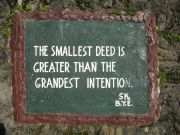
Roadside commercial
...Language?
Or must I say multilingual. We Dutch are proud that we speak at least two languages and that even teeners can speak reasonable good English. Most Dutch will survive in Germany and some will get around in France. Unfortunately we are not the only Europeans who have this talent. The Danish and Swedish can easily compete with us. So, are we Europeans the only ones who are multilingual? No, we are not. Many third world countries are made of different tribes who all speak there own unique language plus the national tongue. So in those poor country, very young kids are already multilingual. Now the Philippines. I was surprised about there language skills. Most Filipinos belong to a tribe with there own distinct language, next to that they speak Filipino. What amazed me most was that most (officially over 50 % in 1990) speak English fluently. Now the Filipino language itself. When you overhear a conversation between Filipinos you can actually get what they're talking about. In just about every sentence there are English words. Sometimes they're just numbers but mostly they're English modern words where thy don't have Filipino words for. For example; twenty years, tomorrow, going, have gone, want to etc. Officially 20% of the Filipino language consist of English words. A lot of magazines, newspapers, TV and outside advertisements are in English. Is that all? No. They also use a lot of Spanish words, being it an old colony of Spain. So when we think that we Europeans are multilingual, think again. You don't have to be a first world country to have this talent.
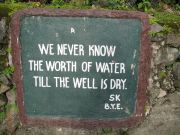
...Shopping?
In countries like the Philippines there are many small places, hard to reach by public transport and to little to have any decent stores. Yes there many tiny shops selling basic necessities. Canned food, shampoo, cookies, toiletries, instant noodles etc. Most of these are sold in small packages. Not 300ml shampoo, but 100ml. Most are even sold in sachets, good for ones. They might sell pen's, writingpaper and candy. It is just enough for the daily routine. Now most of these places grow their own food, so in all, they not really need a big supermarket. But some they do need some supplies from the big city. Unfortunately the people have little money, so no form of own transport. So, to get the goods they need, they write a shoppinglist, at up the expected amount, put some money with it and wait. Wait? Yes, for the first Jeepney or bus to pas by in the morning. They hand the papers over to the driver or his help. In the afternoon, when the Jeepney returns, the groceries are delivered, change returned and shopping is done. Ofcourse they pay something to the driver and help, but it is a lot cheaper then going yourself.
...Beards?
As a man I have a Beard. That is, I grow one each day, but shave myself every now and then. Now I'm not the only man having a beard, every man has that problem... or do they. In Southeast Asia I wondered about that. Here you hardly see a man with a full grown beard. Don't they grow beards? Well, yes and no. First, Asian man are born, raised and get old with a smooth babyface. And looking at them, I don't think they like it. So, when they finally grow a few hears out of the chin they let them grow really long. So, often you meet guys with ten ten centimeter long hear under their chin or out of their cheeks. A strange look. Luckily not all Asian man like the few hears they got. But buyers a razor is expensive, so you see man sitting in front of their house, or anywhere, holding tweezers and peeling the hear out. Still you can actually buy razorblades everywhere and barbers here can still shave you. The last being an interesting experience.
|
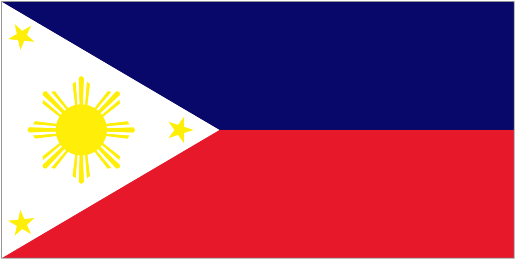
Filipijnen
28-06-08 t/m 22-07-08
Nadat ik nog een nachtje heb doorgebracht in het Maleisische, Kota Kinabalu, vlieg ik de 28ste met Air Asia naar Clark. Dit is een voormalige Amerikaanse luchtmachtbasis nu in gebruik door de Filipijnse luchtmacht en budget airlines. Nabij het vliegveld ligt Angeles en Dau, bekend om de tientallen gogobars en prostitues. Mijn doel is Dau, om vandaar de bus naar het noorden te pakken. Helaas zijn taxi chauffeurs hier heel anders dan ik gewend ben, men wil mij niet naar Dau vervoeren, heel vreemd. Iemand met een brommer brengt me naar de hoofdweg vanwaar ik een jeepney neem naar de maingate. Vandaar verdermet een zijspan (tricycle) naar de busstop. Hier heb ik om 18 pm een bus naar Baguio. Is een luxe bus, met live tv (oa Idols Philipine en American Funniest Homevideos), om 10.30 pm in Baguio en om 11 uur heb ik een kamer voor 410 Pisos (1 Euro = ± 70 pisos). De dag erna besteed ik aan het verkennen van de stad. Er is een moderne boedistische tempel die gesloten is. Een mooie kathedraal waar een dienst bezig is. Een mooi moment om te zien hoe het geloof hier leeft. De deuren staan open en buiten luisteren honderden mensen mee. Kunnen de kerken in Nederland jalours op zijn. In de hoofdstraat vindt je kleine winkeltjes, maar ook de 7elevens, MacDonalds en veel pizzarias. In de grote shoppingcenter trendy shops, bioscoop, coffeeshops een foodcourt en internetshops. Laatste is zeer goedkoop, ongeveer € 0,28 per uur. Dus gebruik ik Skype om even naar huis te bellen. Met een Jeepney ga ik net buiten de stad waar een klein openlucht museum is met wat traditionele huisjes. Daar word ik overvallen door een regenbui, juist, ik zit midden in de regentijd. Na Baguio pak ik de bus, niet meer zo luxe, naar Kabayan. Kabayan is een klein plaatsje in de bergen en de weg erheen is slecht. Gemiddelde snelheid is zo'n 10 km/u. Er is één hotel en ik ben de enige gast, iets wat vaker gebeurt in dit seizoen. Ik wandel eerst naar het kleine museum waar oa een mummy is tentoongesteld. Ik ontmoet hier Virginia die me de dag erna zal gidsen. Na het museumpje loop ik terug door het dorpje naar Opdas Mass Burial Cave. Hier word ik begeleid door een paar jongetjes die de sleutel regelen en wat uitleg geven. De grot is onder en tussen de huizen, klein en voorzien van tientallen schedels en botten. Krijg het idee terug te zijn in het knekelhuis in Tjechië.
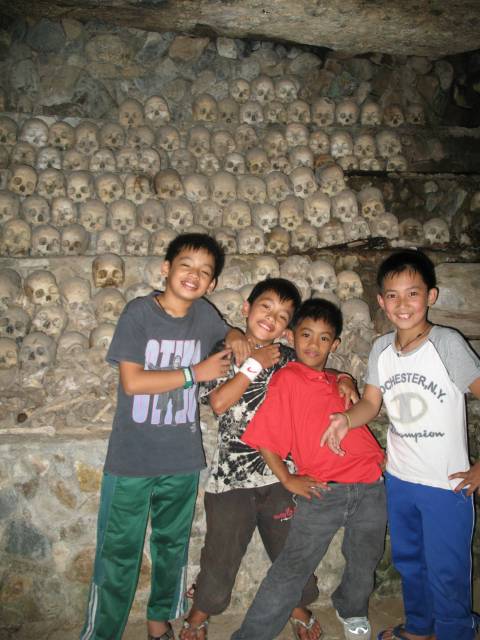
De volgende dag vroeg op en loop om 6.20 am naar het museum. Hier ontmoet ik Virginia weer. Zij draagt mijn dagtas, terwijl ik de wandeling naar de Timbac Caves begin met mijn rugzak. Na de grotten steek ik door naar naar de andere kant van de berg om door te gaan naar Sagada. Het eerste stuk is vlak en mooi, plus zo vroeg is het nog redelijk koel. Echter na een uur steken we een rivier over en gaat de weg redelijk steil omhoog tot de grotten, volgens Virginia iets van drie tot vier uur lopen, oeps. Maar we hebben geluk, na een klein kwartier klimmen komt er een jeepney omhoog kruipen en dit blijkt een neef van mijn gids te zijn. Mazzel, we mogen mee rijden tot de top. Halverwege stoppen we bij een aardig gezin waar we koffie krijgen. De mensen wonen dan wel in een houten huis zonder stroom, maar de kamers zijn ruim en mooi en zien er verzorgd uit. Op de top van de berg is de keykeeper van de grotten, hier moet je je registreren en betalen. Dan via een pad naar beneden en daar zijn de kleine grotten met de kisten. Virginia maakt ze open en ik zit oog in oog met een paar mummies, heel apart. De mummies werden hier weken gerookt met oa tabak, sommige zijn 500 tot 1000 jaar oud. Terug bij the keykeeper lunchen we en lopen dan door naar de andere kant van de berg. Hier haal ik de bus van 2 pm naar Sagada, een wat grotere plaats dan Kabayan met een keuze in hotels. Sagada is ook bekend om zijn overledenen. Hier worden de botten in een kist gedaan en dan opgehangen aan een rotswand of gestapeld in een kleine grot in de rotswand. Twee dagen loop ik er rond. Niet alleen voor de kisten, maar ook voor de natuur. De 4de juli neem ik de jeepney naar Bontoc en van daar naar Banaue. Hier ga ik heen voor de duizenden jaren oude rijstterassen, zo uniek dat ze op de Unesco lijst staan. En ze zijn dan ook schitterend, loop een hele dag langs oude irrigatie kanalen en op de randen van de terassen. Bezoek ook wat kleine dorpjes, in een krijg ik in een huis de botten van opa te zien. Die bewaard men in een doek gestopt in een grote rijstzak. Mijn hotel ligt boven het dorpje en biedt een uniek uitzicht. De zesde met de jeepney terug naar Bontoc voor één nacht. Hier is een leuke markt, een zeer goed museum met buiten replica's van originele huizen inclusief inrichting, plus, zowaar, een goed café met liveband. Hier kom ik Francis tegen, een gids uit Tinglayen die me adviseert hier heen te gaan. Dat doe ik dan ook de volgende morgen met een krappe bus. De weg erheen is een grotendeels onverharde éénbaansweg die slingert door de bergen langs diepe afgronden. In Tinglayen heb ik een kamer in een annex, een gebouw tussen twee rivieren, te bereiken via een hangbrug. Francis is hier ook met een groep uit Manila die een documentaire maken over tribal tattoes. s'Middags mag ik met ze mee om een oude vrouw in een klein dorpje te zien, waarvan beidde armen en als een ketting tattoes zijn aangebracht. Dit gebeurde omdat men dit als schoonheid zag, in de zestiger jaren stopte het echter, alleen oudere vrouwen hebben het nog. De volgende dag ga ik met ze mee de bergen in, de dame in de groep laat bij de laatst levende tattoeerder twee tribaltattoes op haar schouderbladen zetten. Dit gebeurd als volgt; met nat houtskool wordt het patroon gemaakt, hierna wordt een doorn van een citrusplant in een bamboestokje geplaatst, boven het patroon gehouden en dan met een ander stokje wordt het houtskool in de huid getikt. Duurde ruim twee uur en zag er pijnlijk en bloederig uit. Terug in het hotel had Francis een man met tattoes uit genodigd. Dit gebeurde alleen bij een headhunter, er zijn er nog een tien levend. Het was een klein, iel mannetje met een supervriendelijk gezicht, niet voor te stellen dat dit een headhunter is. Nou dode men niet zomaar, dit gebeurde meestal tijdens de stammenoorlogen (die zijn er hier nog steeds, maar men headhunt niet meer). Deze man had vijf Japanners in de oorlog omgebracht. Van de dode werd het hoofd afgehakt en meegenomen, gekookt en de onderkaak als handvat gebruikt op speciale voorwerpen. In het museum in Bontoc liggen er een paar en hangen foto's hiervan. Een unieke ervaring. Twee avonden word ik door Francis meegenomen, eerst naar een neef die een boardinghouse runt voor kinderen uit de bergen en de tweede keer bij hem thuis. Krijg eten en drinken, wat een gastvrijheid. Het bevalt zo goed in Tinglayen dat ik nog een dag blijf om te relaxen. Dan is het weer tijd om verder te trekken en neem ik de tiende een Jeepney naar Tabuc. Wederom veel uren rijden over een onverharde éénbaansweg slingerend door de bergen. Wel weer mooie uitzichten. In Tabuc stap ik over in de volgende Jeepney, nu naar Tuguegarao waar ik aan het begin van de middag ben en ga op zoek naar een hotel uit de Lonely Planet. Is een beetje raar, want deze blijkt 28 kilometer buiten de stad te liggen. Dus na wat lunch en internet met een tricycle erheen. Het hotel, Callao Cave Resort, ligt in Callao een plaatsje bij Peñablanca, het punt van de grotten die ik wil zien. Het is een groot resort, maar ben weer eens enige gast, is ook maar één klein restaurantje.er is niet veel, maar het heeft wel wat. Tuguegarao zag ik alleen maar als een stad met veel walmende tricycles. De dag erna bezoek ik eerst Callao Cave. Een enorme grot met zeven grote zalen waarvan de top is ingestort. In één is een kerk gebouwd. Intressant, niet indrukwekkend. 's Middags loop ik rond in de omgeving en bezoek oa een vlakbij gelegen Negero dorpje. Deze mensen zijn net zo aardig als alle Filipino, maar zien er meer Afrikaans uit, er is nog maar een kleine groep in het hele land. Tegen zonsondergang huur ik een bangka, bootje, voor veel geld om een stuk de rivier op te varen. Hier is een grot en de reden voor mijn bezoek. Met schemering komen hier miljoenen vleermuizen tegelijk uit een niet eens zo'n groot gat vliegen. Duizenden tegelijk komen er uitzetten en dit gaat zeker een kwartier door. Wauw. Aparte plaats.
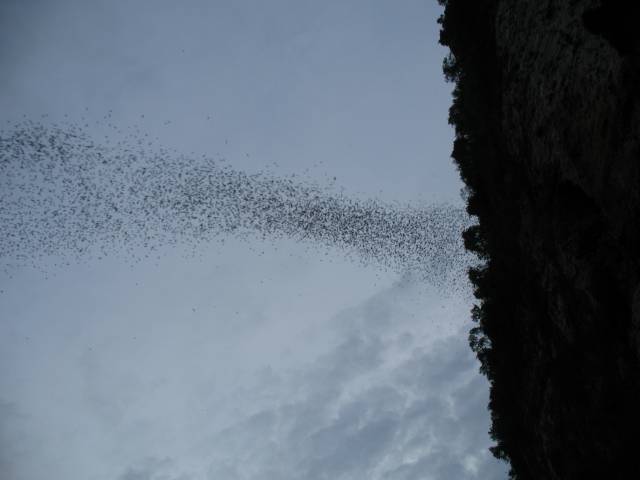
De 12de neem ik een shared tricycle, met vijf anderen, terug naar Tuguegarao en vandaar ga ik door naar Claveria. Ga nu echt de binnenlanden van Luzon uit en naar de noordelijke kust van het eiland. Hier neem ik een kamer in een hotel aan de zee, juist, even lekker zwemmen in de oceaan. Het is niet een sensationele plaats, maar wel relaxed. Er zijn hier twee nederlandse koppels met kinderen en een avond hebben we gezamelijke barbeque aan het strand, erg gezellig. Vlakbij is de jaarlijkse bazaar met als hoogtepunt de huldiging van Miss Claveria. Er staan wat gok attracties, verder zijn er tijdens de huldiging demonstraties van de lokale dansschool en streetdansers. De maandag neem ik weer de bus, dit keer naar Laoag. Mijn eerste 'echte' grote plaats. Hier staan wat kerken die uniek zijn, dus het bezoeken waard. Ik ben er aan het begin van de middag en na lunch bezoek ik eerst de Unesco St Williamskerk. Erg mooi, ze noemen het een kathedraal, maar de bouw is wel anders dan in Europa. Daarna ontmoet ik Maricar die met me mee gaat met de Jeepney naar Paoay. Hier staat een kerk uit 1658 en heeft de unieke aardbevingproof bouw, dikke muren en arken aan de zijkant. Dan naar Batac. Hier kom ik oog in oog met Marco, de eerste president van de Filipijnenen. Volgens Maricar een groot president en intiligent man, blijkbaar heeft ze de geschiedenis niet helemaal goed gelezen en vergeten dat hij duizenden mensen heeft omgebracht. Hij ligt in een glazen kist in een soort mausoleum met graf muziek, het lijkt net een wassen beeld. Ah, en dan de nacht. Dit wordt een ramp. Ik ben in Sumba, Indonesië, gevallen en mijn been was nog steeds niet helemaal beter. Die avond geeft hij er de brui aan en begint te ontsteken. De hele nacht pijn, begin mijn meegebrachte antibiotica en tegen de morgen is het ietsje beter. Ga toch maar even naar het ziekenhuis voor een check. Hier zegt men dat ik een cellulitus infectie heb en krijg andere, zwaardere antibiotica. De rest van de dag lig ik met koorts en pijn op bed. De volgende dag gaat het iets beter, loop 's ochtends wat rond, maar rest van de dag zit ik met mijn been omhoog. De 17de weer iets beter en neem ik de bus naar Vigan. Is niet zo ver. Heb wel een dure kamer, maar met aircon en tv. Na wat rust wandel ik een paar uur door de stad om daarna weer te rusten. Het centrum van Vigan staat op de Unescolijst en is vol met oude spaanse gebouwen. Best wel mooi.
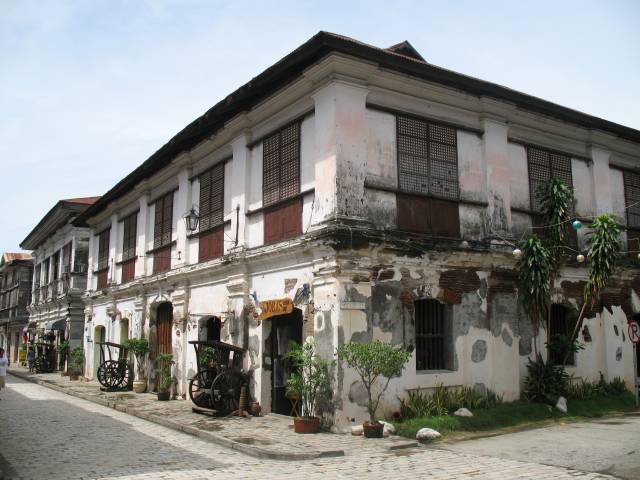
De 18de neem ik de bus naar Manila. Is tien uur zitten en mijn been is het er niet mee eens. In Manila neem ik een bed in een hostel en relax voor ik wat ga eten, ontdanks dat het al laat is. De zaterdag doet mijn been weer erge pijn en besluit ik terug te gaan naar een ziekenhuis. Hier helpen ze goed en spendeer ik een paar uur op de ER van het Philipines General Hospital. Daar wil je niet al te lang verblijven. Hygiene is ver te zoeken en het is er vol met mensen, meest familie van de patienten. Maar, de zusters en artsen doen hun best en weten wat ze doen. Ik mag eerst naar een apotheek medicijnen en naalden halen en terugkomen naar de ER. Ik heb nieuwe weer zwaardere antibiotica en de eerste shot krijg ik via een IV. Privace is er niet en ik deel een bed met een knul met een bloedende vinger. Arts die haar handen wast en aan een vies laken afdroogt, mmm. Maar ze gebruiken wel netjes alcohol en plastic handschoenen als ze me helpen. De rest van de dag wer rustig aan doen, zal nog wel even zo blijven. Lig veel in mijn kamer, gelukkig met airco, met mijn been omhoog. De volgende dag gaat het al iets beter. Been wat minder rood en omgezet, nog wel pijnlijk. Ga toch wat doen en neem 's ochtends de taxi naar Intramuros, de oude ommuurde stad. Platgegooid in WWII door de amerikanen en jappen, er zijn hier meer mensen omgekomen in een week dan door de atoombom in Japzn. Er staat nog een kerk uit 1600, mooi en wederom Unesco protected. Dan door Rizal park, vol met beelden van helden, fonteinen ed en terug naar Robinson plaza. Ok, laatste is shoppingcenter en niet echt interessant, maar koel en ik kan zitten. Rond één uur terug in hethotel en eerst been weer rusten. Mijn laatste dag in de Filipijnen is als de dagen ervoor. Weinig doen, veel zitten en beentje omhoog. Hopelijk gaat het snel beter.
Zo, de Filipijnen dus. Wat vond ik er van. Behalve Manila schitterend. Mensen super aardig en komt in lijst na Myanmar en Iran. Natuur in noord Luzon is schitterend en hier is veel cultuur te ontdekken. Van de regentijd had ik geen last. Voordeel is dat hotels vrij zijn, nadeel is de hoge luchtvochtigheid. De Filipijnen zijn zeker het bezoeken waard. Hou je van zon, zee en strand. Kun je duiken of ben je cultuurfreak, de Filipijnen heeft het allemaal.
What about...
...Believe?
One of the great things about so many different countries and cultures, is that you also see so many ways of religions. Armenian church, Russian Orthodox, Islam , Buddhism, Hinduism, animist and Christianity. Each country expressing its believe in some kind of way and sometimes being very present. I think of Iran (headscarves) and all the many noisy mosques on Lombok. Other then that it is not so bad. Now the Philippines, let me first say it is not overwhelming or
irritating, but you can't but notice. It is not so much the churches you come across , I saw more of those in Sumba Indonesia, it is more the signs in the streets, in the shops and on the tricycles. Everywhere you see them. Then churches are more then full, often having services using outdoor speakers. Here one of the first question asked is; Are you Catholic? It is a bit of getting used to.
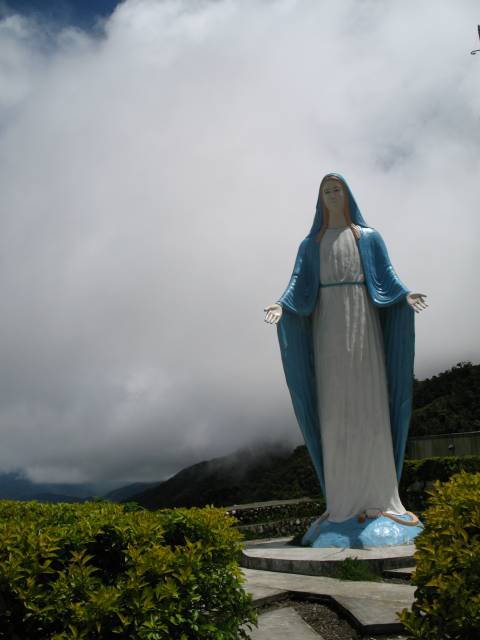
...Summer or winter?
Now this makes an interesting subject. Part of our great world has four seasons namely winter, spring, summer and autumn. Each season having its own kind of weather and temperatures and thus different kind of clothes. The other part of the world has two seasons being the dry and wet season. There is not much variaty in temperature, only in humidity. So, you would say that all the thick winterjackets, sweaters, scarves and cloves are for the cold winter country. Meaning that winterjackets factories can only sell their stuff in a short period of time. Luckily for them the people in the two season area think of the wet season as winter. So when temperature is only a few degrees lower then in the dry season, still being around 30 degrees, they tend to where sweaters, balaklava's and cloves like it is minus 10. This while the person next to him wears only shorts and a T-shirt. Then another interesting way of wearing jackets. In a lot of Asian countries they find it very cold on the motorbike, so they wear a summerjacket. You put it on like this; put you right arm in the left sleeve and your left arm in the right one. Don't bother to sip up, how could you. Oh, and you just wear this when you go shopping, ofcourse still wearing you're helmet.
...Manila?
I ones wrote that capitals of countries do not represent them. Manila is yet another big example. Most people start there trip in a capital to get an idea of how things work and a feel about the country. This time I finished my trip there and was glad by it. Not only because I had a big infection in my leg, which kept me from walking, but it gave me an open perspective of the area I traveled in first. Manila is everything the Philippines are not. It is big, it has a huge smog problem, is full of modern shoppingcenters, hotels and entertainment girls. It looked and smelled as I remembered Bangkok in 1991. It was hot, humid and smoky. People are all in a rush, except the girl's at night who don't mind coming with you, and seem to spend more money a day, than the people in the mountains make in a month. This is the place where it happens and where the money is. It also means the place where the tourist is, so there are thousands of prostitutes. Female, male but unfortunately also children. In some countries like Japan they actually advertise going to the Philippines for the sex. It is also a place where you'll see guy's of over fifty years walking around with 20 year old girlfriends (in Thailand we used to call the Snolliebollies), hoping both to get married. He is in it for the sex, a housemaid and showgirl to friends, she is only in it for the money. I don't think love comes in mind here. So besides the 'working class' you find the beggars, but also a huge amount of streetkids. No house, no parents, only the street. Where is this government when it promotes that all children must have a free education. For them live will end in prostitution or steeling or just in the gutter. Children in the mountains are more likely to have a better future, though basic, then these kids. No, Manila has still a long, long way to go.

|
What about...
...Transport?
Sometimes you think you've seen every type of transportation, but the variaty keeps amazing me. So, a new country and a new kind of vehicle. The first transport I had, arriving in the Philippines was the Jeepney. As the Lonely Planet says; this is what you get, when you cross a jeep with a bus. And that is right. The front of the car is exactly like a jeep, which they then stretch to about 9 meter, looking like a stretched limo. In the back there are benches along the sides which seat at least 20 people. The top looks like taken of a bus and can also be used to transport passengers. To pay you check the price and hand it over to the driver or another passenger. Change will be returned the same way.
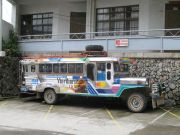
Jeepney take a regular route, just like the Bemo, mashrutky or minibus in other countries.
Next you have the tricycle. This is a fuming twostroke motorbike with a sidecar. Now BMW thought they had something new when they came out with the motorbike with a roof. Wrong. The tricycles here all have a roof and all in different shapes and materials. Some are old and cranky, some are al pieces of art. The sidecar can seat one or two persons, ofcourse they also have a roof above their heads. Most tricycles also have a frame on the back for boxes. In some areas you won't find a Jeepney or taxi. Instead the tricycle will act like a bus. In the sidecar they will fit four people and on the old Kawasaki motorbike they can fit three plus the driver. If people are small, not like me, they transport even more then the seven passengers. Oh, and this does not include the bags and boxes the passengers take with them. So do they only transport people? No. I saw many a tricycle being for transporting goods. Being it four meter planks, a dozen of big boxes or bags of rice or even dozens of pineapples. Ones I saw one transporting a wild boar, though I could not see if it was dead or alive.
...The dead?
In the Indonesian chapter I wrote about a traditional funeral, still an unique experience. In north Luzon I experienced a different way of dealing with the dead. In Sagada the rich have themselves baried in coffins, not unusual, but they don't get baried. When you walk in the area you will notice strange things hanging against the cliffs. Right, that's were they hang the coffins. Question is how do they get there? I can't tell. Some are as old as 500 years. When they have not enough money they stack the coffins in the mouth of a big cave. Then Kabayan, here they mummify the dead. This was only for the rich, because while the bodies were being mummified, they had to offer animals each day. Now how did they mummify the bodies. Well, the dead were smoked. Sound strange, just compare it with smoking fish, only then use tabacco and wood. These mummies are unique 'cause some of them still have there organs intact. When the mummy was ready he or she was put in a wooden coffin in the shape of a boat or rectangular and put in a small cave.
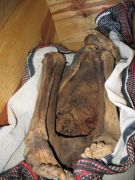
Mummy
The poorer peoples bones were saved and put in a small cave near the city. Here you'll see stacks of bones and skulls. Can it get any stranger? Yes. In Banaue their are tribes that actually berry their dead. Nothing strange about that, but... After two years they dig up the bones, wrap them in a cloth and keep them in their homes. So when I was in Tam-an, I was invited in a house to see the bones of grandpa. There were also bones of another grandfather, plus of the grandmother. Weired? Yes, but then you get used to a lot of strange things. Like the headhunter I met, having five Japanese jawbones in his house as a trophy. And it looked such a nice little man. Oh, biggest thing getting used to? They drive on the right side.
...Building roads?
Now you have roads and roads, question is how to build one. In Europe it is sort of easy. When you leveled the ground, you take a big machine to lay down a thick layer of tar (asphalt). Well in Asia things take a bit more time then then. The first time I was allowed to see this great process going on was in India. What they do is this; First they flatten the ground. Next they dump a huge pile of rocks next to it. The man and woman working are filtering the big rocks out first, which they lay on the flattened ground, making sure no stones stick out. Next they pick out the smaller rocks with which they fill up the holes. Then even smaller rocks, this continues till only tiny holes are left. In the mean time workers are using hammers to make big rocks smaller. At the end the fill up the last hole with sand. Then they go over it with a walls which after they put on a thin layer of tar. You can imagine that roads like that won't last long and they don't. Within a few years the first potholes will appear, followed by many, many more. Now in Europe they will fix the holes quickly, here they don't. Meaning not at all. So after a couple of years the road be worse then it was before. This way of building roads happens everywhere, but not in the Philippines.
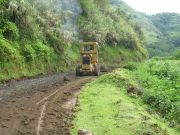
Here they make the roads of 20 centimeters of unarmed concrete. They make this as follows; they flatten en walls the ground. Use wooden planks to measure height and to keep the concrete in. Each part is about two by three meters. Then they fill it up with rough concrete and let it dry. Easy enough you would say. But? While I drove on the winding roads in the mountains of North Luzon they were working on the roads, but in what order. Sometimes the road was finished for a few kilometers, then dirtroad for the next 300 meters, followed by good road for 200 meter. Then 50 meters dirt, followed by 600 meters concrete. Sometimes dirtroad for several kilometers followed by a one lane concrete, dirtroad again and a one lane concrete on the other side. This doesn't make driving in the mountains that easy. Average speed will be less then 20 kilometers per hour. So, while they can actually make good roads, they just don't know where to start.
|